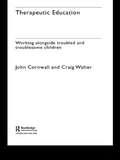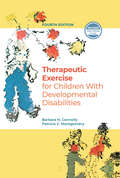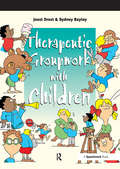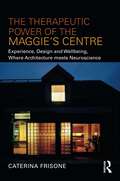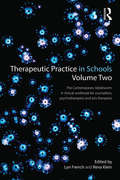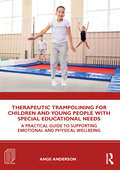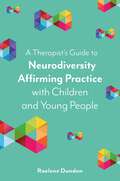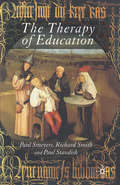- Table View
- List View
Therapeutic Education: Working alongside troubled and troublesome children
by John Cornwall Craig WalterThe role of therapy in schools is a topic that has been significantly under-researched and often overlooked. Considering the number of students in full-time education with serious emotional and behavioural difficulties, the skills and tricks used by therapists can be usefully passed on to teachers in the classroom. This book traces a substantial four-year project that applied the principles of therapeutic education in one school setting and exposed how current educational contexts actually contribute to disaffection and disruption of young people's learning. The authors propose a practical model of school and curricular experience, based on therapeutic relationships, that has led to outstanding positive results in school development. With suugestions throughout for tried-and-tested strategies that really work, this book will help professionals turn troubled young people's experience of education from the nightmare it often is, into an adventure with positive results for lifelong learning.
Therapeutic Exercise for Children with Developmental Disabilities
by Barbara H. Connolly Patricia MontgomeryTherapeutic Exercise for Children With Developmental Disabilities has been expanded and updated to include everything a student or professional needs to know when working with children with developmental disabilities. Continuing the emphasis on evidence-based practice from the previous editions, this comprehensive Fourth Edition enhances critical thinking and evaluation skills. Throughout the course of the text, Drs. Barbara H. Connolly and Patricia C. Montgomery present case studies of 5 children with various developmental disabilities to bring a problem-solving approach to each individual chapter topic. The case studies include 2 two children with cerebral palsy (GMFCS Levels I and V), a child with myelomeningocele, a child with Down syndrome, and a child with developmental coordination disorder and attention-deficit hyperactivity disorder. Each chapter’s examination, evaluation, and intervention recommendations are accompanied by specific treatment objectives and therapeutic activities, plus a companion website with 17 videos, which contains 90 minutes of content to illustrate concepts. Recent research and clinical recommendations, as well as related references, are also provided in each chapter. This Fourth Edition utilizes the American Physical Therapy Association’s Guide to Physical Therapist Practice 3.0 and the World Health Organization’s International Classification of Functioning, Disability, and Health--Children and Youth as its framework. The focus of the chapters is on children’s participation and empowerment, rather than body function and structure. Examples of new and updated topics in the Fourth Edition: • Practice in the NICU • Early mobility strategies • Communication strategies with children and families • Aquatic therapy • Upper extremity constraint-induced therapy • Mirror therapy • Lower extremity treadmill training With helpful videos, informative figures, and compelling case studies, Therapeutic Exercise for Children With Developmental Disabilities, Fourth Edition is the perfect resource for both students and practicing clinicians.
Therapeutic Exercise for Children with Developmental Disabilities
by Barbara H. Connolly Patricia MontgomeryTherapeutic Exercise for Children With Developmental Disabilities has been expanded and updated to include everything a student or professional needs to know when working with children with developmental disabilities. Continuing the emphasis on evidence-based practice from the previous editions, this comprehensive Fourth Edition enhances critical thinking and evaluation skills. Throughout the course of the text, Drs. Barbara H. Connolly and Patricia C. Montgomery present case studies of 5 children with various developmental disabilities to bring a problem-solving approach to each individual chapter topic. The case studies include 2 two children with cerebral palsy (GMFCS Levels I and V), a child with myelomeningocele, a child with Down syndrome, and a child with developmental coordination disorder and attention-deficit hyperactivity disorder. Each chapter’s examination, evaluation, and intervention recommendations are accompanied by specific treatment objectives and therapeutic activities, plus a companion website with 17 videos, which contains 90 minutes of content to illustrate concepts. Recent research and clinical recommendations, as well as related references, are also provided in each chapter. This Fourth Edition utilizes the American Physical Therapy Association’s Guide to Physical Therapist Practice 3.0 and the World Health Organization’s International Classification of Functioning, Disability, and Health--Children and Youth as its framework. The focus of the chapters is on children’s participation and empowerment, rather than body function and structure. Examples of new and updated topics in the Fourth Edition: • Practice in the NICU • Early mobility strategies • Communication strategies with children and families • Aquatic therapy • Upper extremity constraint-induced therapy • Mirror therapy • Lower extremity treadmill training With helpful videos, informative figures, and compelling case studies, Therapeutic Exercise for Children With Developmental Disabilities, Fourth Edition is the perfect resource for both students and practicing clinicians.
Therapeutic Fairy Tales: For Children and Families Going Through Troubling Times (Therapeutic Fairy Tales)
by Pia Jones Sarah PimentaTherapeutic Fairy Tales are a series of short, modern tales, dedicated to supporting young children through challenging situations of life and loss, covering diverse themes such as family breakdown, untreatable illness, and parental depression. Each short story is brought to life by engaging, gentle and colourful illustrations, and can be used by professionals and caregivers to support children’s mental and emotional health. This set also includes the Storybook Manual, which offers practical and creative ideas on how to use illustrated storybooks therapeutically. Exercises have been designed to encourage children’s imagination and creativity, develop confidence and emotional literacy as well as deepen engagement and understanding of storybooks. Books in the series include: Storybook Manual: An introduction to working with storybooks therapeutically and creatively The Storm: For children growing through parent’s separation The Island: For children with a parent living with depression The Night Crossing: A lullaby for children on life’s last journey Designed to be used with children aged six and above, each story has an accompanying online resource, offering therapeutic prompts and creative exercises to support the practitioner. These resources can also be adapted for wider use with siblings and other family members.
Therapeutic Fairy Tales: For Children and Families Going Through Troubling Times (Therapeutic Fairy Tales)
by Pia Jones Sarah PimentaTherapeutic Fairy Tales are a series of short, modern tales, dedicated to supporting young children through challenging situations of life and loss, covering diverse themes such as family breakdown, untreatable illness, and parental depression. Each short story is brought to life by engaging, gentle and colourful illustrations, and can be used by professionals and caregivers to support children’s mental and emotional health. This set also includes the Storybook Manual, which offers practical and creative ideas on how to use illustrated storybooks therapeutically. Exercises have been designed to encourage children’s imagination and creativity, develop confidence and emotional literacy as well as deepen engagement and understanding of storybooks. Books in the series include: Storybook Manual: An introduction to working with storybooks therapeutically and creatively The Storm: For children growing through parent’s separation The Island: For children with a parent living with depression The Night Crossing: A lullaby for children on life’s last journey Designed to be used with children aged six and above, each story has an accompanying online resource, offering therapeutic prompts and creative exercises to support the practitioner. These resources can also be adapted for wider use with siblings and other family members.
Therapeutic Groupwork with Children
by Joost Drost Sydney BayleyThis hands-on workbook is an invaluable resource for all professionals who work with young children, both in clinics and schools, including teachers, activity leaders and therapists. It provides an overview of the book's basis in humanistic philosophy, a discussion of the role of group leaders and how to start and run a group. It contains 40 varied group activities, some original and some more well known, each with clear guidelines, photocopiable worksheets and anecdotal evaluations. Guidance is given on how to use the activities in a pick-and-mix approach, with a gradual build up from simple listening and turn-taking exercises to empathy, problem-solving and dealing with emotions. Divided into activities for infants and juniors, they are designed to use different strengths within the children, including verbal, non-verbal, trust, imagination and physical. Using these activities in a group setting will create an environment, where children feel listened to, accepted and valued, and in which they can grow emotionally.
The Therapeutic Inclusion Program: Establishment and Maintenance in Public Schools
by Murray Michael A. Laura BaloghThis timely guide discusses methods, organizational structures, and philosophies which can be used by school counselors, special educators, and administrators to establish therapeutic inclusion programs in K-12 schools. The Therapeutic Inclusion Program opens with information about therapeutic classrooms and continues with explanations of how the programs function within the larger public school community. As the book travels through the therapeutic program, it discusses staff roles and qualifications, staff-to-student ratios, and the role of administration. Each chapter uses two approaches toward describing the implementation of a therapeutic inclusion program, beginning with a description of the structure and practices, along with the reasoning that supports them, and following with examples from real work experience in the form of vignettes, which will illustrate the concepts and structures in action. Intended for education and counseling professionals looking to design, implement, and maintain an effective therapeutic inclusion program, this book helps fill a noticeable void in public education literature and know-how regarding therapeutic programming.
The Therapeutic Inclusion Program: Establishment and Maintenance in Public Schools
by Murray Michael A. Laura BaloghThis timely guide discusses methods, organizational structures, and philosophies which can be used by school counselors, special educators, and administrators to establish therapeutic inclusion programs in K-12 schools. The Therapeutic Inclusion Program opens with information about therapeutic classrooms and continues with explanations of how the programs function within the larger public school community. As the book travels through the therapeutic program, it discusses staff roles and qualifications, staff-to-student ratios, and the role of administration. Each chapter uses two approaches toward describing the implementation of a therapeutic inclusion program, beginning with a description of the structure and practices, along with the reasoning that supports them, and following with examples from real work experience in the form of vignettes, which will illustrate the concepts and structures in action. Intended for education and counseling professionals looking to design, implement, and maintain an effective therapeutic inclusion program, this book helps fill a noticeable void in public education literature and know-how regarding therapeutic programming.
The Therapeutic Power of the Maggie’s Centre: Experience, Design and Wellbeing, Where Architecture meets Neuroscience
by Caterina FrisoneThis book is about the therapeutic environment of the Maggie’s centre and explores the many ways this is achieved. With an unconventional architecture as required by the design brief, combined with Maggie’s psychological support programme, this special health facility allows extraordinary therapeutic effects in people, to the point that one can speak of therapeutic power.After tracing the story of the Maggie’s centre, the book reveals its fundamentals: Maggie’s Therapeutikos (the-mind-as-important-as-the-body), the Architectural Brief and the ‘Client-Architect-Users’ Triad. It continues by unfolding Maggie’s synergy-that between people and place-which increases users’ psychological flexibility helping them tolerate what was intolerable before. Although comfort and atmospheres are paramount, they are not enough to define the therapeutic environment of the Maggie’s centre. Only by looking at neuroscience that can give us scientific explanations of empathy, feelings and emotions and only considering space neither neutral nor empty, but full of forces that envelop people in an embodied experience, can we explain what generates wellbeing in a Maggie’s centre.The book concludes by critically evaluating the Maggie’s centre as a model to be applied to other healthcare facilities and to architecture in general. It is essential reading for any student or professional working on therapeutic environments.
The Therapeutic Power of the Maggie’s Centre: Experience, Design and Wellbeing, Where Architecture meets Neuroscience
by Caterina FrisoneThis book is about the therapeutic environment of the Maggie’s centre and explores the many ways this is achieved. With an unconventional architecture as required by the design brief, combined with Maggie’s psychological support programme, this special health facility allows extraordinary therapeutic effects in people, to the point that one can speak of therapeutic power.After tracing the story of the Maggie’s centre, the book reveals its fundamentals: Maggie’s Therapeutikos (the-mind-as-important-as-the-body), the Architectural Brief and the ‘Client-Architect-Users’ Triad. It continues by unfolding Maggie’s synergy-that between people and place-which increases users’ psychological flexibility helping them tolerate what was intolerable before. Although comfort and atmospheres are paramount, they are not enough to define the therapeutic environment of the Maggie’s centre. Only by looking at neuroscience that can give us scientific explanations of empathy, feelings and emotions and only considering space neither neutral nor empty, but full of forces that envelop people in an embodied experience, can we explain what generates wellbeing in a Maggie’s centre.The book concludes by critically evaluating the Maggie’s centre as a model to be applied to other healthcare facilities and to architecture in general. It is essential reading for any student or professional working on therapeutic environments.
Therapeutic Practice in Schools Volume Two: The Contemporary Adolescent:A Clinical Workbook for counsellors, psychotherapists and arts therapists
by Lyn French Reva KleinIn common with Therapeutic Practice in Schools: Working with the Child Within (Routledge 2012), this second volume serves as a practical handbook for school-based counsellors, psychotherapists, arts therapists and play therapists working with young people. Written in accessible language, it is eminently applicable to the practice of both qualified and trainee therapists. Therapeutic Practice in Schools: The Contemporary Adolescent begins with an overview of key psychoanalytic ideas informing our understanding of adolescence before moving on to focus on life circumstances and issues which commonly bring young people to the therapist’s consulting room in the school. Dedicated chapters on key themes including identity, relationships, sex and sexuality, anger issues, self-harm, bereavement and bullying aim to deepen our understanding of the adolescent experience while also providing the therapist with invaluable insights into what one might say in the ‘here and now’ of the session. Chapter authors, all with considerable experience in the field, discuss approaches to sustaining the therapeutic relationship in the face of ambivalence or defiant resistance as well as thinking about the impact of social media on all aspects of adolescent development. The advantages and limitations of working with adolescents in the educational setting where school staff will have their own reasons for referring students for therapy, while the young people themselves might come with a very different agenda, are also covered. It is widely acknowledged that engaging troubled or troublesome adolescents in therapy can make an enormous difference to their lives. This book ensures that both trainee and qualified therapists are supported in the often daunting yet ever stimulating and enlivening task of working with young people in the school setting.
Therapeutic Practice in Schools Volume Two: The Contemporary Adolescent:A Clinical Workbook for counsellors, psychotherapists and arts therapists
by Lyn French Reva KleinIn common with Therapeutic Practice in Schools: Working with the Child Within (Routledge 2012), this second volume serves as a practical handbook for school-based counsellors, psychotherapists, arts therapists and play therapists working with young people. Written in accessible language, it is eminently applicable to the practice of both qualified and trainee therapists. Therapeutic Practice in Schools: The Contemporary Adolescent begins with an overview of key psychoanalytic ideas informing our understanding of adolescence before moving on to focus on life circumstances and issues which commonly bring young people to the therapist’s consulting room in the school. Dedicated chapters on key themes including identity, relationships, sex and sexuality, anger issues, self-harm, bereavement and bullying aim to deepen our understanding of the adolescent experience while also providing the therapist with invaluable insights into what one might say in the ‘here and now’ of the session. Chapter authors, all with considerable experience in the field, discuss approaches to sustaining the therapeutic relationship in the face of ambivalence or defiant resistance as well as thinking about the impact of social media on all aspects of adolescent development. The advantages and limitations of working with adolescents in the educational setting where school staff will have their own reasons for referring students for therapy, while the young people themselves might come with a very different agenda, are also covered. It is widely acknowledged that engaging troubled or troublesome adolescents in therapy can make an enormous difference to their lives. This book ensures that both trainee and qualified therapists are supported in the often daunting yet ever stimulating and enlivening task of working with young people in the school setting.
Therapeutic Storywriting: A Practical Guide to Developing Emotional Literacy in Primary Schools
by Trisha WatersLiteracy work can provide a therapeutic context in which to support children with emotional and behavioural difficulties in mainstream schools. This text provides a clear theoretical rationale for therapeutic storywriting.
Therapeutic Storywriting: A Practical Guide to Developing Emotional Literacy in Primary Schools
by Trisha WatersLiteracy work can provide a therapeutic context in which to support children with emotional and behavioural difficulties in mainstream schools. This text provides a clear theoretical rationale for therapeutic storywriting.
Therapeutic Trampolining for Children and Young People with Special Educational Needs: A Practical Guide to Supporting Emotional and Physical Wellbeing
by Ange AndersonThis practical resource explores the benefits of therapeutic trampolining on children and young people with special educational needs. It supports practitioners as they introduce the trampoline into their own therapeutic settings. Trampolining is known to improve balance, co-ordination and motor skills; it can improve bone density and benefit the lymphatic and cardiovascular systems. It has even shown to encourage communication in children with autism and PMLD. This book draws on the author’s extensive experience of delivering both the British Gymnastics Trampoline Proficiency Award scheme as well as the Rebound Therapy trampolining programme. The book also explores the practical side on how to set up and deliver trampolining as a therapy in schools, clubs or in the home. Photocopiable material includes: Lesson equipment, such as schemes of work, lesson plans adapted for varying needs and a trampoline rules poster. Tools for offering therapeutic trampolining sessions such as sequencing cards, communication cards, Risk Assessment, an individual education plan and a communication placemat. All the necessary forms to ensure a safe trampolining environment for all participants, including screening forms, referral and assessment forms and relevant policies. A business plan for after school provision, advertising leaflet and service level agreement. This is an invaluable resource for anybody looking to explore therapeutic trampolining as a way of enhancing the physical and emotional wellbeing of children and young people with special educational needs.
Therapeutic Trampolining for Children and Young People with Special Educational Needs: A Practical Guide to Supporting Emotional and Physical Wellbeing
by Ange AndersonThis practical resource explores the benefits of therapeutic trampolining on children and young people with special educational needs. It supports practitioners as they introduce the trampoline into their own therapeutic settings. Trampolining is known to improve balance, co-ordination and motor skills; it can improve bone density and benefit the lymphatic and cardiovascular systems. It has even shown to encourage communication in children with autism and PMLD. This book draws on the author’s extensive experience of delivering both the British Gymnastics Trampoline Proficiency Award scheme as well as the Rebound Therapy trampolining programme. The book also explores the practical side on how to set up and deliver trampolining as a therapy in schools, clubs or in the home. Photocopiable material includes: Lesson equipment, such as schemes of work, lesson plans adapted for varying needs and a trampoline rules poster. Tools for offering therapeutic trampolining sessions such as sequencing cards, communication cards, Risk Assessment, an individual education plan and a communication placemat. All the necessary forms to ensure a safe trampolining environment for all participants, including screening forms, referral and assessment forms and relevant policies. A business plan for after school provision, advertising leaflet and service level agreement. This is an invaluable resource for anybody looking to explore therapeutic trampolining as a way of enhancing the physical and emotional wellbeing of children and young people with special educational needs.
Therapeutisches Erzählen lernen: Das Wichtigste im Überblick (Psychotherapie: Praxis)
by Stefan HammelDas Buch gibt eine hypnosystemisch fundierte Einführung in das therapeutische Erzählen in Medizin, Kindertherapie und Erwachsenenpsychotherapie, Paartherapie, Familientherapie, Sozialarbeit, Seelsorge, Pädagogik, Coaching, Supervision und verwandten Berufsfeldern. Aus dem Inhalt: Was Geschichtenerzählen mit Therapie zu tun hat. Warum, wann und wie Geschichten therapeutisch wirken. Wo ich therapeutische Geschichten einsetzen kann. Wie ich die rechte Geschichte zur rechten Zeit finde. Wie ich eine therapeutische Geschichte strukturiere. Wie ich anfange und wie ich weitermache. Wie ich meine erzählerischen Fähigkeiten erweitere. Über den Autor: Stefan Hammel arbeitet als systemischer Therapeut, Hypnotherapeut und Autor, als evangelischer Klinik- und Psychiatrieseelsorger sowie als Leiter des Instituts für Hypnosystemische Beratung in Kaiserslautern und als Referent systemischer und hypnotherapeutischer Ausbildungsinstitute in Deutschland, Österreich und in der Schweiz. Er hält Seminare zu Erickson'scher Hypnotherapie, therapeutischem Erzählen, systemischer und hypnosystemischer Beratung. Arbeitsschwerpunkte liegen in den Bereichen Paar- und Familientherapie, Kinder- und Jugendlichentherapie, Depression, Angst, Trauma, Sterbe- und Trauerbegleitung sowie der Unterstützung somatischer Heilung.
Therapist's Guide to Clinical Intervention: The 1-2-3's of Treatment Planning
by Sharon L. JohnsonTherapist's Guide to Clinical Intervention, Second Edition is a must-have reference for clinicians completing insurance forms, participating in managed care, or practicing in treatment settings requiring formalized goals and treatment objectives. This practical, hands-on handbook outlines treatment goals and objectives for each type of psychopathology as defined by the diagnostic and statistical manual by the American Psychiatric Association, identifies skill-building resources, and provides samples of all major professional forms.With over 30% new information, this new edition covers a variety of new special assessments including domestic violence, phobias, eating disorders, adult ADHD, and outpatient progress. New skill-building resources focus on surviving holiday blues, improving communication, overcoming shyness, teaching couples to fight "fair", surviving divorce, successful stepfamilies, managing anger, coping with post traumatic stress, and more. Additional professional forms have been added including treatment plans, a brief mental health evaluation, parent's questionnaire, and a contract for providing service for people with no insurance. Outlines treatment goals and objectives for DSM-IV diagnoses Outlines for assessing special circumstances Offers skill building resources to supplement treatment Provides samples for a wide range of business and clinical forms
A Therapist’s Guide to Neurodiversity Affirming Practice with Children and Young People
by Raelene DundonIn this honest and practical guide, autistic therapist Raelene Dundon explores and demystifies how neurodiversity affirming principles can be easily applied to therapeutic practice.Covering essential considerations for working with neurodivergent clients such as presuming competence, promoting autonomy and respecting communication styles, and providing advice on the best affirming approaches in therapy including how to accommodate sensory needs and encourage self-advocacy, Raelene provides easy-to-implement ways to make your practice inclusive and empowering for neurodivergent children and young people.The deficit model is out. It's time to become neurodiversity affirming.
Therapist's Guide to Pediatric Affect and Behavior Regulation (ISSN)
by Sharon L. JohnsonModeled on the author's bestselling Therapist’s Guide to Clinical Intervention, this new book on child clinical intervention presents much of the material in outline or bullet point format, allowing easy understanding of complex material for the busy therapist. This clinician’s guide to diagnosing and treating disorders in children includes definitions of the disorder, diagnostic criteria, the neurobiology of the disorder, information on functional impairment, treatment planning, and evidence-based interventions. The book additionally offers adjunctive skill building resources to supplement traditional therapy choices as well as forms for use in clinical practice. Outlines treatment goals and objectives for diagnosisDiscusses interventions and the evidence basis for eachOffers skill building resources to supplement treatmentProvides business and clinical forms for use with child patients
The Therapist's Use Of Self
by John Rowan Michael Jacobs"Most therapists, regardless of theoretical approach, intuitively recognize that their sense of self intimately influences their work. Using this elemental truth as a launching pad, Rowan and Jacobs articulate the different avenues through which the self informs therapy, and how each can be used to improve therapeutic effectiveness. Along the way the authors provide a masterful exposition of transference, countertransference, and projective identification, throwing much needed light on topics that have long been mired in controversy and confusion.The book is a priceless resource for experienced therapists and those just beginning the journey."- Professor Sheldon Cashadan, author of Object Relations Therapy and The Witch Must Die: The Hidden Meaning of Fairy Tales "Outstandingly in the current literature, this book meets the conditions for integrative psychotherapy to fulfil its undoubted potential as the therapy pathway of the future. Much has to change in our field. First, people have to become better informed and more respectful of other traditions than their own, engaging with all kinds of taboo topics. Next, vigorous but contained dispute has to take place without having a bland synthesis as its goal. Finally, the current situation in which 'integration' runs in one direction only - humanistic and transpersonal therapists learning from psychoanalysis - has to be altered. Rowan and Jacobs, each a master in his own field, have done a wonderful collaborative job. The book's focus on what different ways of being a therapist really mean in practice guarantees its relevance for therapists of all schools (or none) and at every level." - Andrew Samuels, Professor of Analytical Psychology, University of Essex and Visiting Professor of Psychoanalytic Studies, Goldsmith's College, University of London "There is no question in psychotherapy more important than the degree to which the practitioner should be natural and spontaneous. Would it be sensible to leave one's ordinary, everyday personality behind when entering the consulting room and adopt a stance based on learned techniques? This is the question addressed by Rowan & Jacobs in The Therapist's Use of Self, approaching it from various angles and discussing the relevant ideas of different schools of thought. The authors are very well-infomred and write with admirable clarity, directness and wisdom and have made an impressive contribution to a problem to which there is no easy solution". - Dr. Peter Lomas, author of Doing Good? Psychotherapy Out of Its Depth.This book deals with what is perhaps the central question in therapy - who is the therapist? And how does that actually come across and manifest itself in the therapeutic relationship? A good deal of the thinking about this in psychoanalysis has come under the heading of countertransference. Much of the thinking in the humanistic approaches has come under such headings as empathy, genuineness, nonpossessive warmth, presence, personhood. These two streams of thinking about the therapist's own self provide much material for the bulk of the book - but other aspects of the therapist also enter the picture, including the way a therapist is trained, and uses supervision, in order to make fuller use of her or his own reactions, responses and experience in working with any one client.The book is aimed primarily at counsellors and psychotherapists, or trainees in these disciplines. It has been written in a way that is accessible to students at all levels, but it is also of particular value to existing practitioners with an interest in the problems of integration.
Theraplay® – Innovations and Integration (Theraplay® Books & Resources)
by Rana Hong A. Rand Coleman Phyllis BoothOfficially endorsed by The Theraplay® Institute, this handbook builds on the core concepts of Theraplay® and explores innovative ways to integrate the approach with other therapeutic models for diverse settings and client groups. The book features chapters on the neurobiology of Theraplay®, Tele-Theraplay, and men in Theraplay®, as well as advice for working with traumatized children, neurodivergent children, intergenerational trauma, and homelessness. Throughout the handbook, you'll be encouraged to challenge the limits of your practice and discover new ways to approach challenges using techniques rooted in extensive research-based evidence. Contributions from a wide variety of specialists create a rich tapestry of expertise, providing practical recommendations for integrating Theraplay® with other modalities to give clients the best support for their unique needs.Essential reading for Theraplay® trainees, play therapy practitioners, and professionals working with children, this guide explains the practical applications of cutting-edge research and provides a flexible, effective approach to your practice.
Theraplay® – Innovations and Integration (Theraplay® Books & Resources)
by Rana Hong and A. Rand ColemanOfficially endorsed by The Theraplay® Institute, this handbook builds on the core concepts of Theraplay® and explores innovative ways to integrate the approach with other therapeutic models for diverse settings and client groups. The book features chapters on the neurobiology of Theraplay®, Tele-Theraplay, and men in Theraplay®, as well as advice for working with traumatized children, neurodivergent children, intergenerational trauma, and homelessness. Throughout the handbook, you'll be encouraged to challenge the limits of your practice and discover new ways to approach challenges using techniques rooted in extensive research-based evidence. Contributions from a wide variety of specialists create a rich tapestry of expertise, providing practical recommendations for integrating Theraplay® with other modalities to give clients the best support for their unique needs.Essential reading for Theraplay® trainees, play therapy practitioners, and professionals working with children, this guide explains the practical applications of cutting-edge research and provides a flexible, effective approach to your practice.
The Therapy of Education: Philosophy, Happiness and Personal Growth
by P. Standish P. Smeyers R. SmithThe idea of education as therapy goes back to ancient times. Today, it is understood that the role of the teacher comprises aspects of therapy directed towards the child. But to what extent should this relationship be developed, and what are its concomitant responsibilities? This book offers a challenging philosophical approach to these issues.
